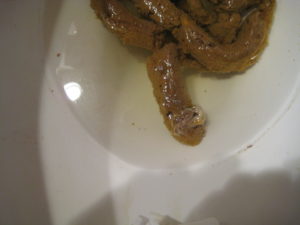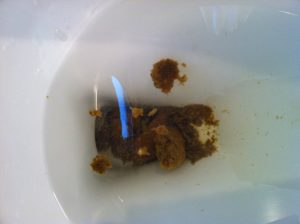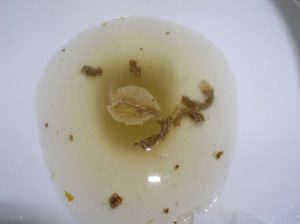Table of Contents
Bowel Movements. . .Are yours normal?
With every new exam I ask the question about yes. . .bowel movements! Some photos in this page are well–poopie! If you are easily grossed out then this is not the page for you.
“How many bowel movements do you have each day? Do you see any mucous, blood, diarrhea or constipation?”
Feces, crap, stools, shit, poop, manure, BM, #2, dung, droppings, and bowel contents are all the same thing. I use all these terms as sometimes my clients don’t know what feces or stool is. If I can’t communicate with my clients, I can’t help them.
And you wouldn’t believe how often I actually get an email with a photo of a bowel movement in the toilet from people who think they have parasites. Actually bowel movement pictures are all part of the job around here. I don’t mind. It’s actually a relief for many people to know what they are seeing in their bowel movement is actually NOT a worm but an intestinal shred or a piece of undigested food or a protein fiber.
So lets get back to what an actual bowel movement is. . .
Feces contains water, indigestible fiber, undigested food, sloughed off intestinal cells, living and dead bacteria, bile, and worn out red blood cells. A normal stool should be brown to light brown, formed but not hard or too soft, cylindrical but not flattened on any side, fairly bulky and full bodied but not compact, easy to pass, and it shouldn’t have an extremely foul smell.
Each bowel movement should be in one piece, about the size and shape of a banana being tapered at the end. Sometimes this will not be discernible if the feces breaks up in the toilet. Some people feel that if the body is absorbing all the minerals from the food that the stool will float. Others believe that the stool should sink. I think the important thing is that there are no air bubbles in the stool and that it doesn’t drop like a brick in the toilet. It should be somewhere in between.
An occasional deviation from this pattern is acceptable. Any chronic deviation from the above pattern is not healthy and should be dealt with.
Irregularities in Bowel Movements Include:
It’s amazing how many people don’t even look at their stools in the toilet. It’s so important. Stools can reveal a lot about your health if you learn to read them. Digestion happens. It’s a shame that few of us are unable to talk about them without embarrassment. For instance:
- Air or bubbles in the bowel movements (stool) can mean that we have a gut or flora imbalance and that gas producing bacteria are overgrown and competing with the healthier flora.
- Alternating bouts of diarrhea and constipation in the bowel movements can be cause by irritable bowel syndrome, food allergies, red meat, spices, sugar, alcohol, stress, lack of fiber, irregular bowel habits.
- Color: Bowel movements are usually the color of the food.
- Constipation can occur leading to impaction–the presence in the rectum of a mass of feces too large to pass. Fecal impaction is usually the result of poor bowel habits, a diet with too little liquid and roughage, too much protein and inadequate physical activity. All these factors can affect the bowel movements.
- Diarrhea, whether acute or chronic, can disrupt the bowel’s normal rhythm and lead to irregularity. It can mean that your large intestine is not functioning properly. The large intestine is in charge of removing excess water from the feces. Rule outs can include food poisoning, lactose intolerance, anxiety, stress, too many antacids, antibiotics, parasites like Giardia or Coccidia, Balantidia, Coccidoidiomycosis or other parasites, viruses, bacterial overgrowth, inflammatory bowel disease and irritable bowel syndrome. A healthy bowel will take about a quart and a half and condense it down to 1 cup of stool. That’s pretty amazing.
- Frank red blood (obvious bright red bleeding) in the bowel movements can be a sign of hemorrhoids, colitis, Crohn’s disease, irritable bowel syndrome, colon cancer or be caused from impacted stools passing through the rectum telling us we need to drink more water.
- Horrible smelling bowel movements—too much protein, flora imbalance.
- If the bowel movements are black, tarry and sticky (called melena), this can mean that there is bleeding from the small intestine. These types of stools usually have a distinctive bad odor. If you’ve ever smelled a dog with Parvo, corona or rotavirus, you know what I mean.
- Light green bowel movements—Too much sugar, fruits or vegetables and not enough grains or salt (or in the case of animals, too much grass)Mucous can reveal diverticulitis and gut inflammation due to allergies or parasites.
- Mucous in the stool indicates the gut irritation and/or parasites
 Can you see the clear coating on the outside of the feces? This could also be fat, but the stool is not floating and there is not layer of fat on top of the water. Mucous can be clear or cloudy.
Can you see the clear coating on the outside of the feces? This could also be fat, but the stool is not floating and there is not layer of fat on top of the water. Mucous can be clear or cloudy. - Oily or greasy looking bowel movements that usually float and can be large can mean that your pancreas or small intestine are not functioning well enough and not releasing enough digestive enzymes. Normal stools are about 1% fat. When this percentage increases to about 7%, the stool will look oily and greasy. This is called steatorrhea. High fat meals can cause this to happen but should be temporary.
- Pale or clay colored bowel movements can mean that your gallbladder or liver is not working correctly.
- Pencil thin or ribbon-like look to the bowel movements can mean you have a polyp or growth on the inside of the colon or rectum.
- Presence of food: If the stool breaks up easily and you can see bits and pieces of the food you ate, maybe you are not chewing your food thoroughly enough. This can cause GERD, acid reflux, abdominal bloating and diarrhea. This one looks to have some kind of undigested grains.

- Red or magenta looking bowel movements— ingestion of beets. No, this won’t hurt you.
- Very dark bowel movements: Too much red wine, too much salt in the diet, not enough vegetables. Blueberries, Pepto Bismol (the bismuth in it) and iron pills can also be responsible for dark stools.
Developing bowel movement habits not only improve the quality of life, they help prevent several common diseases–for example, diverticulitis and fecal impaction. Gall stones, appendicitis, colon cancer, hiatal hernia, diabetes, and heart disease have also been related to the quality of bowel movements and the foods that affect them.
Number of bowel movements: Healthy bowel activity is considered one or two movements of moderate size every day. Every other day or once or twice a week bowel movements can harm you because the bowel contents release toxins back into the body through the mucous membranes. You’ve got to keep that waste moving!
Fecal incontinence (uncontrollable diarrhea in the bowel movements) should be dealt with by a professional. Often with this particular symptom (and irritable bowel syndrome) I will pick up a bowel parasite. A bottle or two of Bowel Pathogen Nosode drops does an awesome job most of the time in clearing up these cases.
Healthy Bowel Movement Habits:
There is usually a time of day when bowel movements are more likely to occur. In anticipation of this time, the patient should participate in activities that stimulate a normal bowel movement. It is also important for the patient to recognize the urge to defecate and to respond right away to that urge. The longer stool sits in the rectum, the more water the rectum will absorb from it, making it harder and more difficult to pass.
The urge to have bowel movements (also called defecation) is often strongest in the morning: Just getting up triggers the movement of the large intestine. The stomach also sends a signal when it expands after a meal. This gastrocolic reflex is the reason many people, and especially children, need to attend to bowel movements soon after eating. The reflex gets weaker with age, which is one source of constipation problems and the reason why good and consistent bowel habits are helpful.
Laxatives: Some patients are so convinced they need daily laxatives to achieve normal bowel movements that they are afraid to do without them. It takes time for a changed diet to affect the bowels and for the bowel to regain its normal rhythm. Be patient. Enemas are a better solution.
Healthy bowel movements require ingestion of a large amount of liquids and bulky foods. The patient should drink two to three quarts of liquids every day. Bulk comes from unrefined foods. Oat bran, wheat bran, brown rice, green vegetables, dried beans, pumpkin, apples, and pears are a few examples of high residue, high fiber foods.
Some patients will benefit from adding bulk preparations of psyllium, but others find that psyllium will cause extreme amounts of gas. For these people, the addition of WHOLE flax seeds (eat without chewing them) and bran will help. And one single 8-ounce cup of coffee in the morning often helps people get a regular bowel movement.
Natural Laxatives for the Stimulation of Bowel Movements Include:
- Anti Constipation Paste: https://naturalhealthtechniques.com/anti-constipation-fruit-paste-recipe/
- Coffee
- DSS (dioctyl sodium sulfosuccinate)
- Glycerine suppositories
- Nature’s Sunshine LBS II (excellent):
- Oil enemas
- Prune juice
- Saline purges
- Fleet enemas are used only for people and dogs. They are very toxic to cats and can kill them. These are OK to use occasionally, but the other enemas we are talking about are better for healing purposes.
- Soap suds enemas can be a little harsh to the intestine. Use these only occasionally if necessary.
Intestinal Bacteria Replacement
Inside a healthy lower intestine are billions of beneficial intestinal bacteria or microflora. These bacteria are of the Lactobacillus acidophilus and Lactobacillus bifidus strains and were transferred by breast-feeding into our intestines as newborn infants. The body uses L. acidophilus and L. bifidus in the final stages of digestion reproducing themselves as necessary to keep in total harmony with the body.
When the good bacteria can’t keep up, bad bacteria overpopulate the gut to give a gut flora imbalance resulting in lower bowel diseases, gas, diarrhea, IBS, and Crohn’s. The devitalizing effect caused by harmful bacteria in the intestine is rarely diagnosed near the beginning of this imbalance. Headaches, skin infections, weakness and constipation can also be symptoms of depleted intestinal bacteria.
What Causes A Gut Flora Imbalance?
- Toxins, especially drugs such as antibiotics and narcotics.
- Severe diarrhea can damage or destroy these beneficial bacteria, allowing harmful bacteria to take over producing by-products like ammonia, purines and ethionine, which can eventually cause colon cancer.
- Fasting can also deplete the beneficial bacteria because large quantities of toxins are dumped from the lymph glands into the colon at the time of the fast.
- Also during a fast, with certain diets and with eating disorders, there is an absence of foods that the good bacteria thrive on.
- Using enemas also depletes the beneficial bacteria, especially if chlorinated water is used.
To reestablish intestinal bacteria, do a couple enemas with liquid acidophilus or live acidophilus. These products should be stored and purchased refrigerated. Off-the-shelf products are not so effective for replacing gut flora. You can also mix a couple tablespoons of active plain yogurt or keifer to your enema mix along with a tablespoon of the liquid acidophilus. Add some warm water, but do not heat the mixture or use chlorinated water.
After blending the mixture, pour it into the enema bag. Use less water for these types of enemas (only 1-2 cups) and try to retain the liquid within the colon for ten minutes to allow the beneficial bacteria to pass up through the intestine. This procedure will ensure that a healthy culture will propagate within the intestines.
You can also start adding L. acidophilus and L. bifidus to your foods a day or two before you break a fast. Use repeat dosages as per bottle instructions once a week for about 5 weeks.
FOS (Fructooligosaccharides) are the best way for reestablishing gut flora. These are long-chain sugars that feed friendly flora. You can purchase this in concentrated pill form or eat lots of apples, Jerusalem artichokes, baked apples or pears. These foods have high amounts of FOS in them.
Well, that’s the scoop on poop. (Some people take things so seriously.)
Pictures of Intestinal shreds in Bowel Movements:
OK, I know this is kind of gross but so many people think they have worms and sometimes they don’t. Below are two photos of intestinal shreds in two totally unrelated bowel movements. On the top bowel movement you can see where the tissue has sloughed off the inside of the intestine. Some digested food is in the center (it kind of looks like one of those flowers you get in Hawaii). You can also see some gas bubbles near the center of the photo and a little to the lower left. And some ribbony diarrhea at the lower half of the photo.
The upper half looks like there is undigested plant material in it and if we took a sample and looked under the microscope you’ll see bits of plant material with rectangular cells in it. The greenish borders of the plant cell will definitely be visible. This type of stool abnormality is more common in Blood Type A people over the age of 40 who don’t chew their food well enough and who eat too much animal-based protein. This blood type often doesn’t have enough hydrochloric acid in their stomach to digest meals that have lots of animal protein in them. Adding antacids only makes this worse.
I’m including these photos in the handout so you can start to talk to your doctor intelligently to them so you can get better treatment. The photo beneath that shows an intestinal shred right in the middle of the toilet bowl.
Helpful Links and References for What is a Normal Bowel Movement:
- Enemas: https://naturalhealthtechniques.com/enemas/
- The Coffee Enema: https://naturalhealthtechniques.com/coffee-enemas/
- Detoxification Tips and Tricks: https://naturalhealthtechniques.com/detoxification-tips-tricks/
- 10 Things to learn from your Bowel Movements: https://www.goodnewsnetwork.org/10-amazing-things-you-can-learn-from-your-poop/?utm_campaign=newsletters&utm_medium=weekly_mailout&utm_source=23-10-2019


